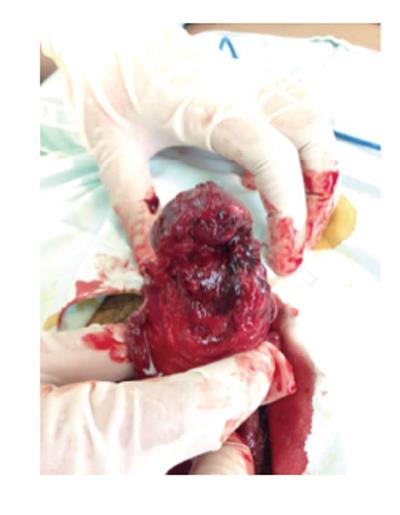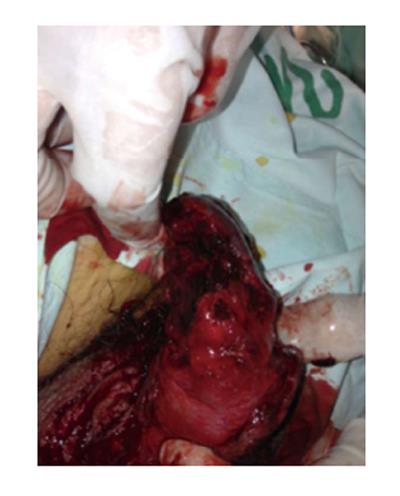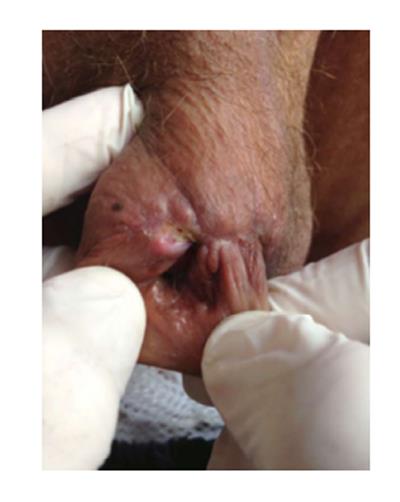Published online Oct 16, 2014. doi: 10.12998/wjcc.v2.i10.587
Revised: June 30, 2014
Accepted: August 27, 2014
Published online: October 16, 2014
Twenty percent of genital traumas are caused by penetrating injuries; accordingly gunshot and stab wounds have increased in the last couple of years around the globe, even in Colombia. A 67-year-old male patient was admitted to the emergency room because he received multiple gunshot wounds. On physical examination, multiple wounds on his penis with loss of tissue in the foreskin, glans, anterior urethra (distal third) and cavernous corpora were found. The urologist performed a partial penectomy with a penis reconstruction, he debrided the cutaneous flap of the dorsal foreskin and its glans, sutured the distal cavernous corpora and dissected the urethra. Penetrating genital injuries are extremely important due to their impact on the functional, psychological and the aesthetic consequences. It is necessary to define the best possible treatment to minimize the damage.
Core tip: Genital injuries are a common problem in civil war. For example, in developing countries its incidence is increasing, so it is of vital importance to notice how to focus the clinical case and how to treat patients with this condition. The impact on functional and aesthetic aspects calls our attention to treat these patients correctly.
- Citation: García-Perdomo HA. Importance of defining the best treatment of a genital gunshot wound: A case report. World J Clin Cases 2014; 2(10): 587-590
- URL: https://www.wjgnet.com/2307-8960/full/v2/i10/587.htm
- DOI: https://dx.doi.org/10.12998/wjcc.v2.i10.587
Twenty percent of genital traumas are caused by penetrating injuries[1-3]; with traumatic amputations-as part of genital traumas-usually happening in acute psychotic events[4-6]. In only a small percentage they are caused by agricultural and industrial accidents or even by gunshot or stab wounds[4-6]. Due to a raise of civil war conflicts, gunshot and stab wounds have increased in the last couple of years, especially in Columbia[7], making this type of injuries prevalently seen at Hospital Universitario del Valle (Cali, Colombia). In both males and females, the penetrating genital injuries occur with other associated injuries in 70% of cases[8,9].
It is therefore important to know that the injured persons will have a different degree of damage and that the urologists will have to determine the probability of reattaching the part of the amputated or reconstructing the injured penis[4].
The purpose of this report is to describe an interesting case of a genital gunshot wound associated with a literature review to support the case and treatment, according to CARE guidelines for Case Reports.
A 67-year-old male patient was admitted to the emergency room because he received multiple gunshot wounds. On physical examination, a suprapubic and multiple wounds on his penis were found, with loss of tissue in the foreskin, glans, anterior urethra (distal third) and cavernous corpora on the left side (Figures 1 and 2). Because of the extent of injuries and the inability to have a permeable urinary tract, a suprapubic tube (cystostomy) was placed and a surgical cleansing and debridement were performed.
On the next hospitalization day, he was taken to the operating room, where following conditions were found: devitalized glans with some necrosis areas, loss of the pendulous urethra up to its middle third, and a partial loss of its foreskin, but with some good cutaneous flap remaining. The urologist decided to perform a partial penectomy with a penis reconstruction, he debrided the cutaneous flap of the dorsal foreskin and its glans, sutured the distal cavernous corpora and dissected the urethra. Following the reconstruction a urethral Foley catheter was placed.
Three days after his admission, on his second postop day, he was managed as an outpatient due to good clinical status.
As an outpatient, two months later, he showed up with good clinical status, the surgical wound was healed but some left-sided retraction of the neomeatus was found (Figures 3 and 4).
In an emergency room, a patient with multiple injuries or even with isolated genital damage requires prompt assessment and course of action[3]. Sometimes it is important to assess the range, caliber and type of weapon to evaluate the amount of the damage, before the treatment can be initiated[1]. Primarily physicians should focus on life threatening conditions and their treatment; and only then focus on genital and associated trauma. The surgical approach will depend on the site of the damage but a lateral or a sub-coronal degloving should supply a good exposure[3].
The first principles of caring of genitalia are debridement of devitalized tissue, preservation of as much viable tissue as possible, diversion of urine, hemostasis and removal of foreign bodies if necessary[3]; the conservative management is election for most cases[10]. If some tissue is not completely viable, the conservative management is encouraged for a delayed penile repair, perhaps 4 wk after trauma[3]. A tunica albuginea defect could be repaired easily but if bigger damage is found, the surgeon should use an autologous or xenograft[3].
When loss of genital skin is mild to moderate, reconstruction with the same skin is preferable but when an extensive injury is encountered, a full-thickness skin graft should be established for reconstruction[10,11]. This could be taken from the abdomen, buttock, thigh or axilla, depends of the preference of the surgeon[11].
According to the grade of damage, there are a variety of treatments, for example: closure of residual stump, surgical reanastomosis or total phallic substitution with reconstruction[4,12].
The penis and the amputated part should be washed out and debrided with saline or ringer solution[3,13] in every case. If replantation is attempted, it should be done within 24 h with proper maneuvers and conservation of the amputated part (usually the glans) because success has been reported within this time[14] and this could be performed in a micro or non-microvascular approach with better results in the first one[3].
Particularly in this case, the patient had a genital gunshot wound with loss and devitalized tissue: the glans, the urethra and the cavernous corpora, so the replantation was not indicated, then the second choice of treatment was used as literature says: a closure of the penile stump was performed (cavernous corpora) and the urethra was spatulated as in a standard partial penectomy[4]. The phallic substitution with reconstruction is usually recommended for patients with a good mental status and after the episode has passed and the patient is stable[4], but this is not going to be discussed in this article.
The postoperative management should include: antibiotics for the risk of infection, a Foley catheter for the urethral reconstruction, and some dressings over the penis[4]. These recommendations are based on descriptive studies due to the lack of clinical trials to assess the best treatment possible.
Based on the aesthetic and functional results the patient could need a second or third surgery accompanied by the plastic surgeon[4,15], for example, this patient will need a reconstructive surgery to place the parts where they go and also perhaps an urethral reconstruction to assure the functional status.
It is important to recognize the need to interact with different specialists for example the plastic surgeon, the psychologist/psychiatrist, and the urologist for sure[4]. This is not something easy to treat, so the general physician, the urologist and every doctor involved in the treatment should recognize, diagnose and treat according to the damage to minimize the sequels.
This case allows us to recognize and to keep in mind how important and relevant these injuries are due to their impact on the functional, psychological and the aesthetic consequences. It is necessary to wash out and debride the injured tissue and consequently, defining the best possible treatment to minimize the damage.
A male patient received multiple gunshot wounds.
Multiple wounds caused tissue lost in the foreskin, glans, anterior urethra and cavernous corpora.
There are not differential diagnosis, but according to the findings urologists need to check for damage to the urethra, glans and cavernous corpora.
The treatment offered to this patient was a partial penectomy along with penis and urethral reconstruction.
Partial penectomy: to take a part of the penis off. Cystostomy: to put a suprapubic tube to permit drainage of urine from the badder.
The author confirmed how important and relevant these injuries are due to their impact on the functional, psychological and the aesthetic consequences.
This paper is well-written, and this case report is informative for readers.
P- Reviewer: Hori T S- Editor: Ji FF L- Editor: A E- Editor: Liu SQ
| 1. | Brandes SB, Buckman RF, Chelsky MJ, Hanno PM. External genitalia gunshot wounds: a ten-year experience with fifty-six cases. J Trauma. 1995;39:266-271; discussion 271-272. [PubMed] [Cited in This Article: ] |
| 2. | Phonsombat S, Master VA, McAninch JW. Penetrating external genital trauma: a 30-year single institution experience. J Urol. 2008;180:192-195; discussion 195-196. [PubMed] [DOI] [Cited in This Article: ] [Cited by in Crossref: 61] [Cited by in F6Publishing: 41] [Article Influence: 2.6] [Reference Citation Analysis (0)] |
| 3. | Summerton DJ, Djakovic N, Kitrey ND, Kuehhas F, Lumen N, Serafetinidis E, Sharma DM. Guidelines on Urological Trauma. Eur Urol. 2014; Available from: http: //www.uroweb.org/gls/pdf/24Urological Trauma_LR.pdf. [Cited in This Article: ] |
| 4. | Chang AJ, Brandes SB. Advances in diagnosis and management of genital injuries. Urol Clin North Am. 2013;40:427-438. [PubMed] [DOI] [Cited in This Article: ] [Cited by in Crossref: 27] [Cited by in F6Publishing: 21] [Article Influence: 1.9] [Reference Citation Analysis (0)] |
| 5. | Aboseif S, Gomez R, McAninch JW. Genital self-mutilation. J Urol. 1993;150:1143-1146. [PubMed] [Cited in This Article: ] |
| 6. | Jezior JR, Brady JD, Schlossberg SM. Management of penile amputation injuries. World J Surg. 2001;25:1602-1609. [PubMed] [DOI] [Cited in This Article: ] [Cited by in Crossref: 83] [Cited by in F6Publishing: 98] [Article Influence: 4.3] [Reference Citation Analysis (0)] |
| 7. | Dogra PN, Gautam G, Ansari MS. Penile amputation and emasculation: hazards of modern agricultural machinery. Int Urol Nephrol. 2004;36:379-380. [PubMed] [DOI] [Cited in This Article: ] [Cited by in Crossref: 5] [Cited by in F6Publishing: 3] [Article Influence: 0.2] [Reference Citation Analysis (0)] |
| 8. | Tiguert R, Harb JF, Hurley PM, Gomes De Oliveira J, Castillo-Frontera RJ, Triest JA, Gheiler EL. Management of shotgun injuries to the pelvis and lower genitourinary system. Urology. 2000;55:193-197. [PubMed] [DOI] [Cited in This Article: ] [Cited by in Crossref: 22] [Cited by in F6Publishing: 22] [Article Influence: 0.9] [Reference Citation Analysis (0)] |
| 9. | Jolly BB, Sharma SK, Vaidyanathan S, Mandal AK. Gunshot wounds of the male external genitalia. Urol Int. 1994;53:92-96. [PubMed] [DOI] [Cited in This Article: ] [Cited by in Crossref: 7] [Cited by in F6Publishing: 8] [Article Influence: 0.3] [Reference Citation Analysis (0)] |
| 10. | McAninch JW, Kahn RI, Jeffrey RB, Laing FC, Krieger MJ. Major traumatic and septic genital injuries. J Trauma. 1984;24:291-298. [PubMed] [DOI] [Cited in This Article: ] [Cited by in Crossref: 65] [Cited by in F6Publishing: 69] [Article Influence: 1.7] [Reference Citation Analysis (0)] |
| 11. | Summerton DJ, Campbell A, Minhas S, Ralph DJ. Reconstructive surgery in penile trauma and cancer. Nat Clin Pract Urol. 2005;2:391-397. [PubMed] [DOI] [Cited in This Article: ] [Cited by in Crossref: 19] [Cited by in F6Publishing: 21] [Article Influence: 1.2] [Reference Citation Analysis (0)] |
| 12. | Charlesworth P, Campbell A, Kamaledeen S, Joshi A. Surgical repair of traumatic amputation of the glans. Urology. 2011;77:1472-1473. [PubMed] [DOI] [Cited in This Article: ] [Cited by in Crossref: 15] [Cited by in F6Publishing: 17] [Article Influence: 1.3] [Reference Citation Analysis (0)] |
| 13. | Jordan GH. Initial management and reconstruction of male genital amputation injuries. Traumatic and reconstructive urology. Philadelphia: WB Saunders 1996; 673-681. [Cited in This Article: ] |
| 14. | Roche NA, Vermeulen BT, Blondeel PN, Stillaert FB. Technical recommendations for penile replantation based on lessons learned from penile reconstruction. J Reconstr Microsurg. 2012;28:247-250. [PubMed] [DOI] [Cited in This Article: ] [Cited by in Crossref: 18] [Cited by in F6Publishing: 16] [Article Influence: 1.3] [Reference Citation Analysis (0)] |
| 15. | Garaffa G, Raheem AA, Ralph DJ. An update on penile reconstruction. Asian J Androl. 2011;13:391-394. [PubMed] [DOI] [Cited in This Article: ] [Cited by in Crossref: 26] [Cited by in F6Publishing: 24] [Article Influence: 1.8] [Reference Citation Analysis (0)] |












